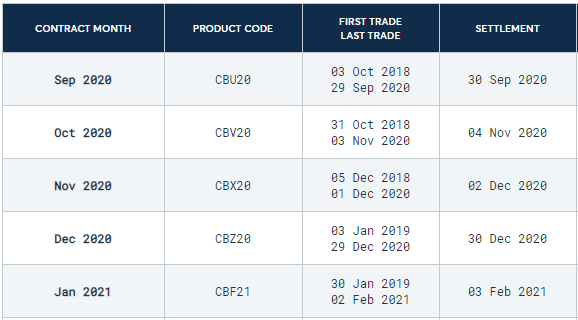A hot take on the financial compliance industry in 2020 is that technology has never been more important.
An even hotter take is that technology will continue to play an increasingly important role in the future. Especially in areas where specific data is required to secure accurate compliance monitoring. Position Limits monitoring under regulations such as MiFID II and CFTC is one of those areas.
The spot month position limit rule puts a limit on the amount of contracts an investor can hold in the month in which the contracts expire. The limits, which need to be respected in order to avoid monetary fines, and more importantly, reputational damage, come into effect on a specific date, which is typically 5-10 trading days before the last trading day of the contract. Let’s have a look at an example:
The classic CB (Cash-settled butter futures) contract is traded on the Chicago Mercantile Exchange with monthly delivery, meaning that the spot month will roll over every month. The spot limit is as low as 100 contracts for the butter futures and is applicable 6 trading days before the last trading day. So, in order to adhere to the limit, we need to know when the contract stops trading. That information is outlined in the contract’s trading calendar which is published by the relevant exchange, often on it’s website. See an example below:

Spot month limit rules are not the only place where the trading calendar information is relevant. The so called “Other Month” rule under MiFID II also requires input related to when contracts stop trading. Let’s take the EBM (Wheat Milling No.2) contract traded on the Euronext Paris as our next example:
The Other Month limit for EBM is 60,000 contracts across all trading months (except for the current spot month). The EBM contract has delivery in March, May, September and December. Before the spot month roll-over, the limit is increased to 100,000 to allow investors to keep their exposure during the rolling period. The increased limit comes into effect 21 trading days before the last trading day of the current spot month contract.

Monitoring a few contracts traded on a single or maybe a few different exchanges is doable. However, keeping track of calendar information if you trade larger amounts of contracts on more than a few different exchanges can be a very labour intensive and risky task. Trading calendars come in all possible formats: html, xml, csv, pdf, json etc.
| XML |
CSV |
Excel |
|
HTML |
ICS |
JSON |
| CBTS |
CXOT |
MFOX |
XASX |
BVMF |
XEUR |
XKFE |
| CECS |
IEPA |
XAMS |
XCBO |
C2OX |
XFRA |
XKCM |
| CMEC |
IFCA |
XEEE |
XJSE |
XCBF |
XHKF |
XKEM |
| CMEE |
IFED |
XEMD |
XLME |
XCBO |
XHKG |
|
| CMES |
IFEN |
XEUC |
XSAF |
XMGE |
XSWX |
|
| FCBT |
IFEU |
XEUE |
XSFA |
XMOD |
||
| FCME |
IFLL |
XEUI |
XSFE |
|||
| NYMS |
IFLX |
XLIS |
YLDX |
|||
| XCBT |
IFSG |
XMAT |
||||
| XCEC |
IFUS |
XMON |
||||
| XCME |
IFUT |
XPAR |
||||
| XIOM |
IMAG |
|||||
| XNYE |
IMEN |
|||||
| XNYL |
IMFX |
|||||
| XNYM |
IMIR |
This is where the hot technology comes into play. At FundApps we automatically scrape and parse calendar information across 44 exchanges, making sure that our clients can easily navigate the effective date of limits directly affecting their positions and compliance obligations. So far in 2020, we have navigated 371 changes made by the exchanges to these data sources. These changes could have meant the difference between compliance and non-compliance.
Don’t let trading calendar regulations for Position Limits catch you off guard! Get in touch today to see how our automated solution can save you time and mitigate the risk of fines.Looking for more information on how to monitor and manage Position Limits effectively? Then check out our recent webinar with FIA Tech here!
